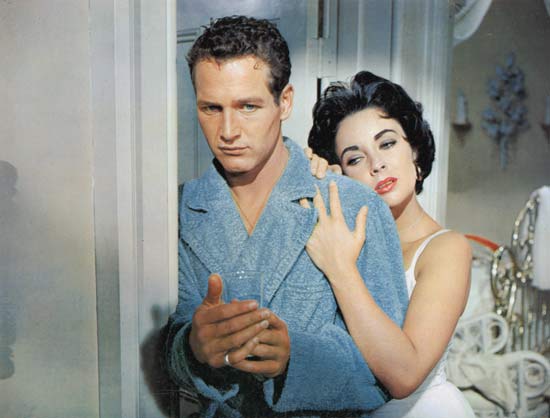I have never been particularly fond of Tennessee Williams. Part of this may be because I’m not his intended audience, but with very few exceptions (I enjoy A Streetcar Named Desire), I find his stuff a little, well, airy for my taste. Reading his plays and novels, and comparing them to the films made out of them, I often get the sensation that he was a poet — his work often features striking and beautiful language, and moments of revelation that remind of some of the best modernist poetry — who realized early on that poetry wasn’t any way to make a living a the midway point of the 20th century, and so turned his essentially poetic talents to forms where they were not particularly well-used. His one-act plays, in particular, are often simply opposing monologues, with no especial attention paid to the dramatic form — in other words, they are people standing on stage reading poetry at one another. It’s a bit short-sighted to accuse a playwright of having no gift for realistic dialogue; after all, no one speaks like a character in a Shakespeare play. But Williams’ characters are such nebulous creatures, such gossamer creations rarefied from the world of real events and people, that they seem to naturally inhabit the printed page, and forced to exist in the living world, they come off as almost absurd.
Added to this is another factor that is no fault of his own: he enjoyed his greatest success as a writer at a time when Hollywood was both unwilling and unable to present most of the major themes in his material to the viewing public. Obviously, homosexuality was the foremost of these, but Williams also wrote, albeit in the most delicate and poetic way, about effeminacy, impotence, incest, drug addiction, and any number of other subjects that were more or less completely taboo at the time. So you had a situation where a man who was arguably the most famous playwright in the country, and thus reasonably the subject of any number of directors’ and producers’ attention, creating story after story that could not hope to make the transition from stage to screen with any of the thematic elements that drove their narratives intact. The result was one compromised film after another. It was hard enough to translate his material to film; it was excessively stagey without having a solid sense of theatrical storytelling, the language was fruity in every sense of the word, and it all contained speeches that required plenty of audience patience to get to the (admittedly often rewarding) catharsis. But the filmmakers also had to find a way to finesse their way around the controversial issues and still have the stories make sense.
Still, one solid director after another found themselves drawn to the challenge, so I still find myself watching film adaptations of his plays despite the ever-increasing possibility of disappointment. I thought I’d finally learned my lesson after an excruciating double-feature some years ago of Suddenly Last Summer and Boom!, but I recently, in the midst of a Richard Brooks kick, found myself watching the 1958 film version of Cat on a Hot Tin Roof. Unfortunately, it didn’t do much to change my mind. The story of a childless young couple dealing with the imminent demise of the wealthy family patriarch moves along with the speed and efficiency of a wounded dugong, and Williams’ highfalutin dialogue has never sounded more ridiculous. Of the entire cast, whoozy ol’ Burl Ives is the only one who gives a performance that seems remotely human; Elizabeth Taylor, not in the best of health, sounds downright hooty when called upon to say things like “That fertility monster, she’s downright odious to him”, and Madeleine Sherwood as Mae constantly looks like her eyeballs are going to explode out of her head. Even Paul Newman looks like he’s trying to rip off James Dean in Rebel without a Cause and has no idea how to go about it. Brooks and James Poe may be the ones to blame for some of the more rank dialogue, but it wasn’t their idea to natter on about the “powerful and obnoxious odor of mendacity”, or to make the Ditkoesque move of naming the handsome ex-jock Brick and the ineffectual softie Gooper. The filming is very handsome, and the cast are all easy on the eyes, but all in all, Cat on a Hot Tin Roof is another item in evidence that whatever magic Williams possessed, it was best left in its particular time and place.


And the ending ranks up there with The Simpsons‘ bowdlerized ending of Gone With the Wind. “Aw, let’s have a kid anyway, shucks ‘n stuff.”
I don’t think this artifice of “staginess” is limited to just Tennessee Williams film adaptations. All filmed plays, at least all the ones I’ve seen, go “ker-plonk!” on screen. Shakespeare? Mamet? Albee? Ker-plonk, ker-plonk, ker-plonk, doesn’t matter who’s doing it, unless they get far away from the source material.
Now, of course the Cat on a Hot Tin Roof movie is ridic. Taylor in particular is just embarassing. But I will keep re-watching it just to get my fill of Burl Ives stomping around abusing everyone. All that stuff about mendacity coming out of his mouth makes total sense. And I don’t mind Mae, either…I somehow don’t think it’s a coincidence that those two did the bestt job and happened also to be in the play’s first run.
Pingback: The Most Beautiful Fraud: Cat on a Hot Tin Roof « Screengrab In Exile